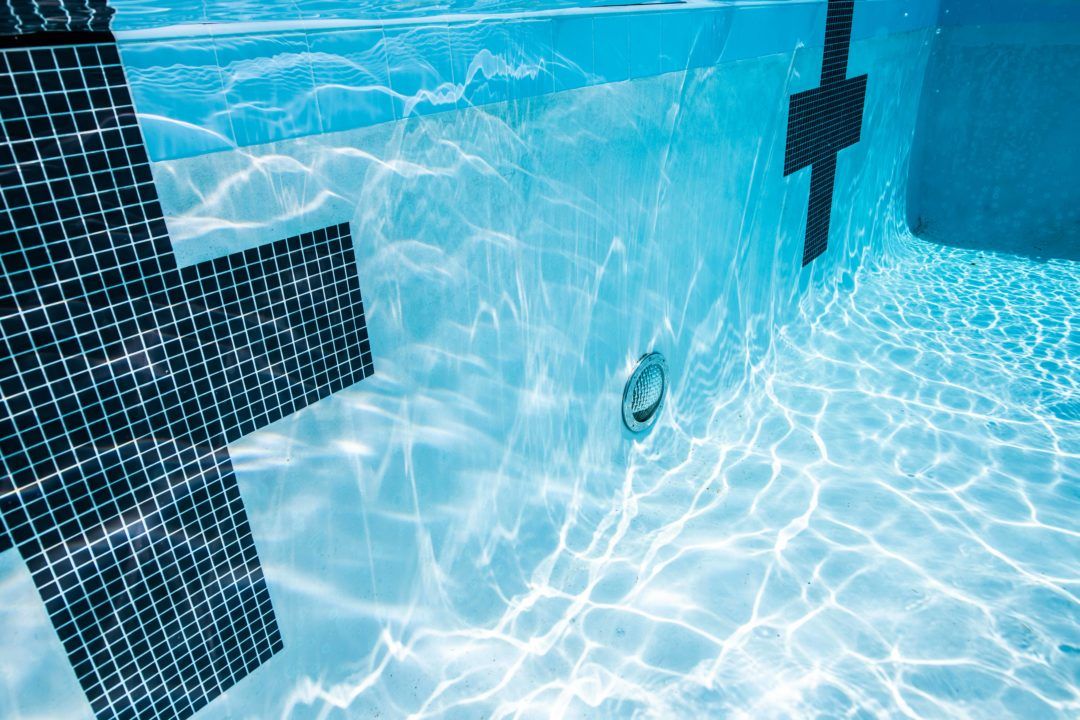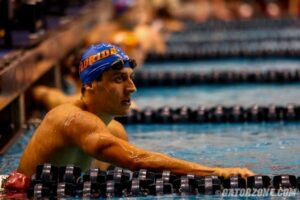Courtesy: Carlos Omana
As a high school and collegiate swimmer, I always lifted after practice because the idea was that we did not want to be fatigued before practice. Now, as a strength and conditioning coach, I know that this idea can be flawed.
Yes, the priority is and always will be, to swim fast. However, if done correctly, lifting before practice can actually help swimmers have a better practice and overall season. Let’s dive in.
First off, swimmers rarely, if at all, should be maxing out for 1 rep on any lift. That does not mean, however, that swimmers can’t be strong. With that being said, weight room sessions should always be intended to improve a swimmer’s capability to swim fast. It should be designed in conjunction with what the swim coach has planned so that the two stimuli collaborate with each other. Here are two ways lifting before practice can be beneficial:
Micro-dosing: What rule exists that lifting sessions have to be at least an hour long and as heavy as possible? What if instead of lifting 2-3 times a week, we extend those over four, five, or even 6sixdays? We can spread out the exercises and volume so that the swimmers train for maybe 20-30 mins before practice.
Benefits of micro-dosing include:
The lift can be used as a warm-up before practice, improving position, increasing body temperature, and addressing weaknesses.
Allows swimmers to be more lenient as to when they can lift. If a swimmer schedules lifts three times a week and misses one lift, they miss 33% of training. If they are lifting six times a week and they miss one, they only miss around 16%.
Training more often accelerates the swimmer’s skill set with movements in the gym, allowing them to get more out of their gym sessions and improve their strength capabilities. If a swimmer trains a split squat more often, for example, then they will be more proficient and skilled at it and can produce higher outputs.
Undulating Fatigue and Recovery: Throughout each week, there are usually (and should be) high and low-intensity days/practices. Communication between the swim coach and strength coach is crucial to ensure both stimuli complement each other. A common mistake is using low-intensity practice days as an opportunity to complete a higher-intensity lift since the swimmer is more “fresh”. While this may be true, instead of undulating your high and low days to optimize performance and recovery, every day is high now, hindering recovery capabilities.
That being said, a way to optimize practice and recovery capabilities is to match both training stimuli. If the swim coach has a high-intensity speed practice planned, the lift before practice can be dynamic or explosive to excite the nervous system leading into practice. If the swim coach has a distance or volume practice planned, the lift can be lower intensity, higher volume to promote blood flow and prepare the swimmer for the anticipated demands.
In the world of strength and conditioning, when a battery of tests are completed, testing always occurs from least fatiguing to most fatiguing. This limits the amount that one test affects the next, allowing for optimal results. For example, testing a one-mile run before testing a vertical jump would not be ideal. The swimming world is no different. This can apply to the idea of lifting before practice. Again, the lift should not be more fatiguing than practice and should be used as a way of improving practice. If swimmers arrive at practice fatigued from the weight room, there needs to be a re-evaluation of the program and fatigue management.
 ABOUT CARLOS OMANA
ABOUT CARLOS OMANA
Carlos Omana, owner of White Water Method, trained under Coach Kirk Peppas and at the University of Florida during his swimming career in addition to representing Venezuela internationally after his collegiate career. After swimming, Carlos pursued a career in strength and conditioning. He graduated with his M.S. in Human Performance and received certifications as a Certified Strength and Conditioning Specialist, USAW Level 1 Performance Coach, Performance Enhancement Specialist, and Certified Physical Preparation Specialist. In 2024, he started White Water Method which aims to help swimmers and coaches tackle physiological obstacles such as joint discomfort, technique issues, strength, power, mobility, etc. White Water Method is reinventing and improving the old school dryland training that swimmers know all too well.


Coaches should not be mixing strength training and swim training. You want maximum time in between strength and swim training. This allows your body to recover and adapt to the stimulus of strength training and then the specific swim training. Example would be morning lifting session and afternoon swim. See this study for data backng this up: https://pubmed.ncbi.nlm.nih.gov/25546450/
Articles like this are why the US almost lost in medal count. In short, if you dont push yourself when you lift it yields no benefits, it’s like only doing easy swims.
An easy fix would be lifting in an afternoon session at the very end of the day
If the intensity is high but low volume, lifting shouldn’t affect practice later much if you’re a in shape athlete. Every athlete if different, but any of my swims or runs after lifting are not noticeably impacted negatively. Lifting AFTER a swim session or run, that’s never as productive as the power output is lower from overall fatigue.
Lift then swim/run is the way. Obviously your body and your teammates body could be affected differently but properly conditioned athletes should 1. Gain Strength a few days a week in the gym and 2. Practice their sport whether it’s swimming or running or throwing, Rugby etc. as much as needed.
You can never be too strong
Kind of correct, but not entirely. A swimmer can be “too strong” to the point where the muscle mass can impede performance, so the whole body shape and composition needs to be accountable to results the greater the level of athlete. It’s a real science and one that becomes more a factor the more elite the athlete becomes.
“too strong” as a result of increased muscle mass is different from what Ragnar is talking about. (I think) …High effort low volume lifting emphasizes muscle fiber recruitment of *existing* muscle fibers, especially in the 6×1 @ 90% 1RM, 5×2 @ 85% 1RM range. The stimulus of hypertrophy requires volume of reps per set.
Power to weight ratio is the name of the game for athletes. Doing more with less has such a significant impact on performance. The holy grail is movement patterns performed with a high effort, low volume protocol that have a high degree of transferability to the biomechanical motions a sport requires.
No, you can never be too strong. You can be too heavy and immobile though but never too strong.
Arnold Schwarzenegger is/was stronger than mostly everyone else on the planet, why doesn’t he hold swimming world records? Answer: because you can be too strong to the point where it impedes performance……like I said.
All depends on how we determine and measure “strength”. Strongest for one set of criteria is not necessarily the same with another set of criteria. Which is why Ragnar is “Kind of correct”.
Strength is not a 1:1 correlation with muscle size. Strength training is not the same as hypertrophy training.
A good program will know the difference and train in a way that reaches the goal the best, adding muscle or adding strength depending on the individual.
You can never be too strong, strength and muscle mass is why men are 11% faster than woman in the 50 and 8% faster in the 800
I do see the merits of this argument. I am a Master’s swimmer and there are two challenges I have: (1) I have second day soreness. This means if I swim and lift on Monday and have recovery Tuesday, the soreness will hit me on Wednesday, which would be my next swim and lift day. This is why I typically alternate between swim and lift. That way, when I lift, my second day soreness comes on a recovery day, not a swim day. (2) It is challenging to do a two-a-day on a regular basis if I want to keep both high intensity swimming and lifting on the same day.
TNM, I am also a masters swimmer. Quite frankly, it seems like there is a lot of confusing/conflicting information on strength training.
Do you, or Mr. Omana, have any thoughts/resources on strength training that focuses on speed for the “older” master swimmer? thanks.
So regardless of whether someone is a masters swimmer or high school swimmer, force is force and in order for speed to occur, that force needs to be applied appropriately. There are a few pieces to the puzzle here.
First, there needs to be a certain level of strength to propel the body forward at a significant rate. Second, the body needs to be able to appropriately get into positions to produce force with the correct body parts (muscles, joints, etc) and not compensate with others (If a breastroker’s hips can’t internally rotate properly, then getting stronger or doing more kicking at practice has diminishing returns). Lastly, once the body can do both of those things, then force needs to… Read more »
Mr. Omana,
Thank you so much for your reply. Very helpful explanation that makes sense. I will check out your website.
I’m still trying to figure it out, too. Two things I can share:
(1) Check out Fike Swim on YouTube. He is on a similar journey and shares his training regime.
(2) Check out this article, especially “Hit the Weight Room” section: https://cd2.usms.org/fitness-and-training/articles-and-videos/articles/short-course-nationals-day-4-recap-national-champions-share-their-advice-for-the-50-freestyle